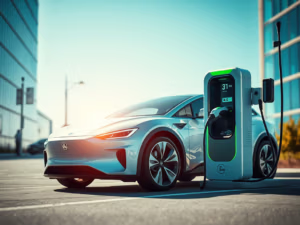As electric vehicles continue to gain popularity, misconceptions and myths about their viability persist. Let’s examine the top ten arguments against EVs and explore what the data actually tells us.
1. “EVs Are Worse for the Environment Due to Battery Production”
This might be the most common anti-EV argument, but it doesn’t hold up to scrutiny. While it’s true that manufacturing EV batteries requires more upfront energy and emissions than producing traditional vehicles, the lifetime environmental impact tells a different story.
According to the Union of Concerned Scientists’ 2020 study, EVs more than make up for their manufacturing emissions:
- The average EV reaches its “break-even” point in just 6-18 months of driving
- Over their lifetime, EVs produce 60-68% fewer emissions than gas-powered vehicles in most countries
- As power grids continue to incorporate more renewable energy, the advantage grows even larger
2. “EVs Don’t Have Enough Range”
The “range anxiety” argument becomes less valid with each passing year. Modern EVs offer plenty of range for typical driving patterns:
- Current EVs average 250-300 miles per charge
- New models like the Tesla Model S and Lucid Air exceed 400 miles
- The US Department of Transportation reports that 95% of car trips are under 30 miles
- The average American drives just 39 miles per day
For most drivers, range anxiety is more psychological than practical.
3. “Charging Takes Too Long”
Charging time needs to be considered in context. Here’s the reality:
- Most charging happens at home overnight when your car isn’t being used
- DC Fast charging can replenish 10-80% battery in 20-40 minutes
- New 350kW chargers are dramatically reducing charging times
- Unlike gas cars, you start each day with a “full tank” when charging at home
Consider how often you actually need to charge on the go versus having a fully charged car each morning.
4. “The Grid Can’t Handle Mass EV Adoption”
This concern has been thoroughly studied and debunked. The Pacific Northwest National Laboratory’s 2023 grid study found:
- Existing grid capacity can handle 70%+ EV adoption
- Most charging occurs during off-peak hours
- Smart charging technology helps balance grid load
- Vehicle-to-grid (V2G) technology could actually strengthen grid resilience
- Utilities are actively preparing infrastructure for increased adoption
5. “EVs Are Too Expensive”
While upfront costs can be higher, total cost of ownership paints a different picture:
- Federal tax credits up to $7,500
- Additional state and local incentives available
- Maintenance costs approximately 50% lower than gas vehicles
- Fuel savings of $6,000-$10,000 over five years
- Strong residual values
- Price parity with gas vehicles expected by 2025
Consumer Reports’ 2023 analysis shows that EV ownership often costs less over time than comparable gas vehicles.
6. “Battery Replacement Costs Are Prohibitive”
The reality of modern EV batteries is far different from early perceptions:
- Batteries typically last 10-20 years
- Most manufacturers offer 8-10 year/100,000+ mile warranties
- Battery costs have dropped 89% since 2010 (BloombergNEF)
- Battery recycling programs are becoming mainstream
- Many EVs will outlast traditional vehicles
7. “EVs Perform Poorly in Cold Weather”
Cold weather impacts all vehicles, not just EVs. The Norwegian EV Association’s data shows:
- EVs remain reliable in extreme cold
- Pre-conditioning while plugged in eliminates cold starts
- Heat pumps provide efficient cabin heating
- Norway, with its harsh winters, leads global EV adoption
- Range reduction in cold weather is manageable with proper planning
8. “EVs Aren’t Green If Powered by Coal”
The International Council on Clean Transportation’s 2023 study demonstrates:
- EVs produce fewer emissions even in coal-heavy grids
- Grid mix is rapidly becoming cleaner
- Renewable energy costs continue to decrease
- Many charging networks use 100% renewable energy
- Home solar integration creates zero-emission transportation
9. “There Aren’t Enough Charging Stations”
Charging infrastructure is expanding rapidly:
- Over 50,000 public fast chargers in the US
- More than 140,000 Level 2 public chargers
- $7.5 billion federal investment in charging infrastructure
- Major private sector charging network expansion
- Complete coverage of major highway corridors
10. “EVs Are Just a Fad”
Market trends strongly suggest otherwise:
- Global EV sales doubled in the past two years
- Every major manufacturer has committed to EV production
- Over 130 new models coming by 2025
- Battery technology improving rapidly
- Many countries planning to phase out gas vehicle sales
Conclusion
The transition to electric vehicles represents a fundamental shift in transportation, backed by improving technology, expanding infrastructure, and clear environmental benefits. While legitimate challenges exist, the data shows that most common arguments against EVs are based on outdated information or misconceptions.
As battery technology continues to improve, charging infrastructure expands, and prices decrease, the advantages of EVs become increasingly clear. The future of transportation is electric – not because of ideology, but because of practical benefits and technological progress.











